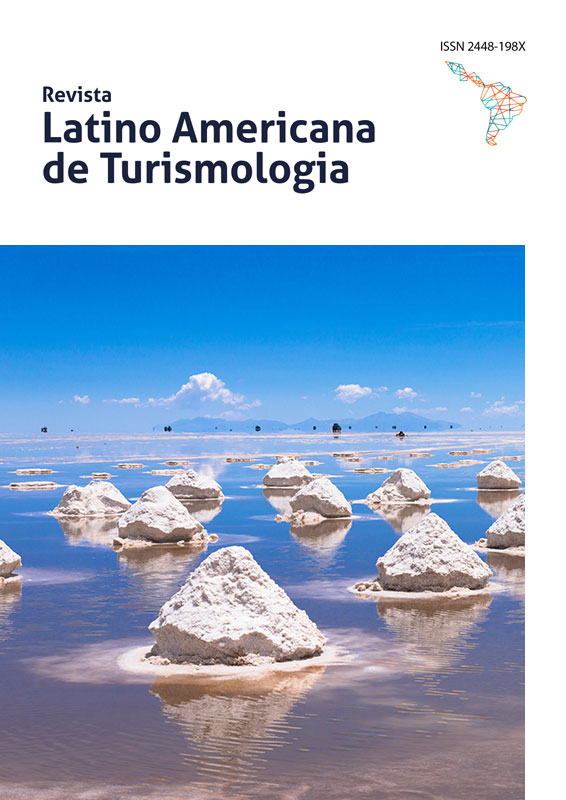Orchids as a Tourist Resource in the Southern Area of Manabí Province
DOI:
https://doi.org/10.34019/2448-198X.2019.v5.14032Palavras-chave:
Biodiversity, orchids, tourism, ManabiResumo
Este artigo consiste em analisar o potencial das espécies endêmicas e orquídeas representativas da província de Manabí que investiga e determina sua importância para o turismo. Como o Equador é um dos países que possui uma grande diversidade de famílias Orchidaceae e outras plantas vasculares, a província de Manabí apresenta importantes recursos de riqueza, como as orquídeas, para desenvolver uma oferta turística de natureza altamente diferenciada. Uma seleção de amostragem, observações participativas e entrevistas com informantes-chave foram realizadas para o desenvolvimento da pesquisa (25); também foi realizada uma busca por informações, inclusive através da revisão de publicações e relatórios sobre dados botânicos e turísticos. Sessenta e um (61) orquídeas e cinco híbridos foram identificados no total. Os gêneros mais representativos Epidendrum (6), Oncidium (5), Dendrobium (4) Pleurothallis (4) e Stelis (3). Conclui-se que a organização de identificação mostra a necessidade de implementação de caminhadas interpretativas, integrando educação e conservação observando as orquídeas em seu ambiente natural, permitindo a geração de renda econômica, explorando o potencial das comunidades locais, integrando todos os atores locais.
Downloads
Referências
Briassoulis, H. (2017). Tourism destinations as multiplicities: The view from Assemblage Thinking. International Journal of Tourism Research, 19(3), 304-317.
Ceron, C., Palacios, W. A., Valencia, R., & Sierra, R. (1999). The natural formations of the Ecuadorian coast. In R. Sierra, preliminary proposal for a vegetation classification system for continental Ecuador. (pp. 59-81). Quito, Ecuador: INEFAN/GEF-BIRF project and EcoCiencia.
Cornejo, X., & Hagsater, E. (2014). Epidendrum aromoense (Orchidaceae, Laeliinae), A New Species From The Coastal Dry Forests In Western Ecuador . Harvard Papers in Botany, 19 (2), 185–188.
Dodson, e.H. y A.H. Gentry. 1991. Biological extinction in western Ecuador.
Annals of Missouri Botanical Garden 78:273-295.
Endara, L., Dodson, C., & Jost, L. (2000). 2000. Orchidaceae. Pp. 257-384. In
S. Leon-Yanez, R. Valencia, N. Pitman, L. Endara, & C. Ulloa, 2000. Red Book of the endemic Plants of Ecuador, 1st edition. Publications of the QCA Herbarium, Pontifical Catholic University of Ecuador. Quito.
MAE. (2015). Fifth Biodiversity Report. Quito.
Martinez Perez, I., Lopez Trabanco, P. J., & Orta Pozo, S. (2013). Strategy of sociocultural-environmental promotion with community participation for the conservation of Cuban orchids. (C. D. Río, Ed.) Scientific journal Avances, 15 (2), 122-133.
SNAP. (28 de 09 de 2017). National system of protected areas of Ecuador. Obtained from the national system of protected areas of Ecuador: http://areasprotegidas.ambiente.gob.ec/es/info-snap.
Rozo Mora, M. C., Castellanos Castro, C., & Romero, L. (2017). Guidelines for conservation and sustainable use of native orchids in Cundinamarca. Workshop Memories, Cundinamarca.Santamaría Freire,
E y Bayas Vásconez F. M, (2018). Economic effect of tourist activity in the province of Tungurahua, Ecuador. Administrative Sciences 6 (11): 15 – 25. ISSN: 2314 – 3738.
Thome-Ortiz, H., Tejeda-Sartorius, O., Tellez Velasco, M., & Torres Rivera, J. (2017). Orchids (Orchidaceae) as a tourist resource: Proposal of interpretative trails as a tool for sustainable forest management. AgroProductividad, 10 (6), 54-61.
Zotz, G y J.L Andrades. (2002). The ecology and physiology of epiphytes and hemiepiphytes. In: Neotropical Forest ecology and conservation. Regional University book. San José: Technological Editorial of Costa Rica. 271-291 pp. 271-291 pp.
Downloads
Publicado
Como Citar
Edição
Seção
Licença
Salvo quando expressamente indicado em contrário, todo o conteúdo desta revista (RELAT) está licenciado por Creative Commons, Atribuição Não Comercial / Sem Derivações / 4.0 / Internacional (CC BY-NC-ND 4.0).
Portanto, os autores concordam que as obras publicadas nesta revista estão sujeitas aos seguintes termos:
1. A Universidade Federal de Juiz de Fora, por meio do seu Centro Latino Americano de Turismologia (CELAT), aqui denominado como o editorial, conserva os direitos patrimoniais (direitos autorais) das obras publicadas.
© Centro Latino Americano de Turismologia (CELAT), Universidade Federal de Juiz de Fora (UFJF), 2020.
2. Pode-se copiar, usar, difundir, transmitir e expor publicamente, desde que: i) seja citada a autoria e a fonte original de sua publicação (revista, editorial e URL da obra); ii) não seja utilizada para fins comerciais; iii) seja mencionada a existência e as especificações desta licença de uso.





